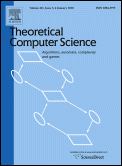 W
WElectronic Notes in Theoretical Computer Science is an electronic computer science journal published by Elsevier, started in 1995. Its issues include many post-proceedings for workshops, etc. The journal is abstracted and indexed in Scopus and Science Citation Index.
 W
WIn computational complexity theory, a generalized game is a game or puzzle that has been generalized so that it can be played on a board or grid of any size. For example, generalized chess is the game of chess played on an board, with pieces on each side. Generalized Sudoku includes Sudokus constructed on an grid.
 W
WIn mathematics and theoretical computer science, a set constraint is an equation or an inequation between sets of terms. Similar to systems of (in)equations between numbers, methods are studied for solving systems of set constraints. Different approaches admit different operators on sets and different (in)equation relations between set expressions.
 W
WThe spectral test is a statistical test for the quality of a class of pseudorandom number generators (PRNGs), the linear congruential generators (LCGs). LCGs have a property that when plotted in 2 or more dimensions, lines or hyperplanes will form, on which all possible outputs can be found. The spectral test compares the distance between these planes; the further apart they are, the worse the generator is. As this test is devised to study the lattice structures of LCGs, it can not be applied to other families of PRNGs.
 W
WIn theoretical computer science, stuttering equivalence, a relation written as
 W
WTheoretical Computer Science (TCS) is a computer science journal published by Elsevier, started in 1975 and covering theoretical computer science. The journal publishes 52 issues a year. It is abstracted and indexed by Scopus and the Science Citation Index. According to the Journal Citation Reports, its 2018 impact factor is 0.718.
 W
WIn cellular automata, the von Neumann neighborhood is classically defined on a two-dimensional square lattice and is composed of a central cell and its four adjacent cells. The neighborhood is named after John von Neumann, who used it to define the von Neumann cellular automaton and the von Neumann universal constructor within it. It is one of the two most commonly used neighborhood types for two-dimensional cellular automata, the other one being the Moore neighborhood.